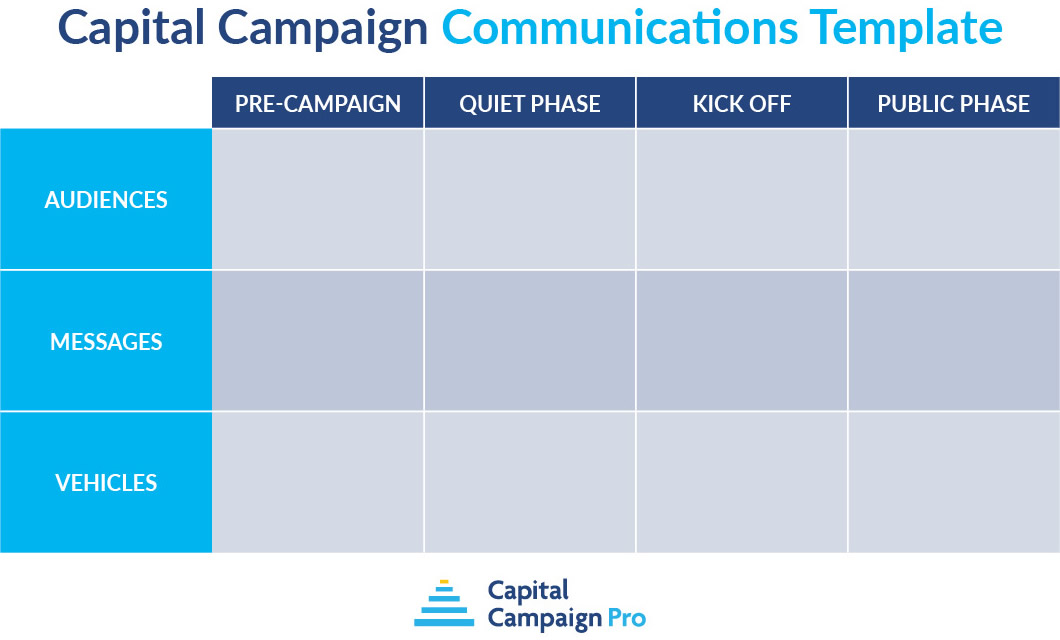Capital Campaign Plan: 11 Essential Elements & Top Tips

Capital campaigns are major undertakings, and every nonprofit considering starting one should have a plan. However, many nonprofits also likely aren’t sure exactly what to include in their plans.
For decades, nonprofits have relied on consultants to write their capital campaign plans. While these experts can provide valuable insights and experienced advice, you likely won’t know all the ins and outs of your campaign if you completely hand off its planning to someone else.
To help you better understand exactly what’s going on behind the scenes when it comes to capital campaign planning, this guide will explore:
- What Is a Capital Campaign Plan?
- How To Develop Your Capital Campaign Plan
- Top 3 Tips for Your Capital Campaign Plan
Are you ready to create a winning capital campaign plan to empower your team? Let’s get started!
What Is a Capital Campaign Plan?
A capital campaign plan is a collection of vital information about your campaign. It’s often organized into one document and spells out how you’ll conduct your campaign.
A clear, well-written capital campaign plan serves as an essential reference for every decision you make over the course of your campaign.
Whether your plan is a meticulously organized spiral-bound notebook, a three-ring binder, or a simple Word document with navigation, the goal is to create a campaign guide that will benefit your team as you start your campaign.
Capital Campaign Timeline Key Phases
Before discussing the creation of your capital campaign plan, let’s explore a quick overview of the main phases of a capital campaign:

0. Campaign Readiness
1. Pre-Campaign Planning
2. Feasibility Study
3. Campaign Planning
4. Quiet Phase
5. Kick-Off
6. Public Phase
7. Post-Campaign
Your campaign plan is constructed during phases 0-3, where you assess your campaign readiness, set goals, conduct your feasibility study, and formally start planning. While you will finalize your plan in phase three, the preceding phases provide the materials and information you need to create that plan.
As we discuss the essential elements to include in this plan, remember that these elements aren’t compiled on day one. Following our capital campaign phases timeline, it can take months (and sometimes even a year or more) to develop your campaign plan.
How To Develop Your Capital Campaign Plan
During the early stages of your campaign, you’ll assemble the earliest components of your campaign plan and test them by conducting a feasibility study. For example, you might chart out a few potential major giving prospects, then check in with them during the feasibility study to see if their giving potential lines up with your predictions.
Once your feasibility study is done and you have a clearer sense of the campaign’s potential course, you’ll finalize these elements and pull together all of the pieces of the plan. Bringing all of these elements together into a single document will bring your campaign into clear focus.
11 Elements to Include in Your Capital Campaign Plan
1. Objectives
What is your campaign raising money for? Common answers include building or renovating facilities, upgrading technology, or even creating an endowment fund.
When planning your campaign, identify your main objective (e.g., “construct a new facility”) as well as key specifics related to it. For this sample objective, you would need to answer questions like:
- What will the building be used for?
- What will the new construction look like?
- What are the benefits of the new construction when it comes to advancing your cause?
Your major donors will ask questions like these when you approach them about giving, so ensure you have clear, accurate responses.
2. Goals
Goals and objectives are closely related, but there is a distinction between the two in capital campaign planning. Your objective is the target end result of your campaign (i.e. building a new facility), while goals revolve around specific campaign metrics related to your objective.
Campaign goals will include a mix of financial goals (i.e., how much you need to raise) and non-financial goals (e.g., expanding your donor base or identifying and engaging more major gift prospects).
Non-financial goals can help you reach your financial goals and set your organization up for continued success after your campaign wraps up. For example, if you expand your pool of major giving prospects, you will have more potential donors to contribute to your annual fund and other campaigns.
3. Gift Range Chart
When planning your capital campaign, estimate that about 70% of your total fundraising revenue will come from your 20 largest gifts. With these numbers in mind, you’ll need to consider who your prospective major donors are and how much each of them is likely willing to give.
This is where a gift range chart comes into play. Your gift range chart should list the gift amounts and number of gifts at each level that you’ll need to reach your goal. Check out the example below:

A gift range chart breaks down your fundraising goal into numbers. However, major giving relies on individual human relationships.
Put names to potential giving amounts by creating a depth chart. A depth chart lists donors according to the amounts on the gift range chart that they will likely be willing to give.

On your depth chart, list all of your qualified prospects for major giving. Along with individual donors, you might also list foundations and corporations that have the potential to make a major gift.
This process helps you brainstorm giving prospects, identify if you have the capacity to achieve your fundraising goal, and plan one-on-one meetings with major giving candidates to begin cultivating their support.
4. Donor Recognition
Capital campaigns require support from a lot of donors, and proper recognition is essential for getting them to champion your cause and continue supporting your nonprofit after your campaign wraps up.
As part of your campaign plan, determine how you will recognize donors. Use the levels in your gift range chart to structure your recognition strategy. For example, you might divide your donors into three tiers:
- Lead donors. Lead gifts are the biggest contributions to your campaign and are essential for getting your fundraising efforts off the ground. For these donors, you should provide appropriately significant recognition, like awarding them naming rights to an area of your newly constructed facility.
- Major donors. While not investing as much in your campaign as lead donors, major donors are still vital to your capital campaign’s financial success. While you might reserve naming spaces and buildings for lead donors, you may still want to honor these supporters by listing their names on a donor wall, statue, or plaque.
- General donors. During the public phase of your campaign, you’ll open contributions up to mid-level and small-dollar donors. Although these supporters lack the capacity to make major gifts, they still deserve recognition. You might send these supporters personalized thank-you messages or even handwritten cards if they make a mid-sized gift.
To properly recognize your donors, you might plan numerous appreciation strategies. For example, you might turn your donor wall unveiling into a large appreciation event when lead and major donors are also recognized in speeches and given personal awards or gifts.
Whatever your plan, nail down as many specifics of your recognition strategy during the planning phase. This way, if you host events or appreciation activities, you’ll be organized ahead of time.
5. Structure
“Structure” refers to how your capital campaign team is set up. When putting your team together, consider:
- Leadership structure. Consider whether you’ll have co-chairs, honorary chairs, and how they will work alongside the existing structure of your nonprofit.
- Committees and task forces. Determine what committees you’ll feature in your campaign, such as major gifts, event planning, and community gifts management.
Be aware that you might form some committees before finalizing your exact structure. In particular, your capital campaign will have a planning committee who are responsible for reviewing feasibility study results and assembling other documents and resources into your capital campaign plan.
6. Staffing
Your capital campaign plan should spell out the responsibilities staff members will have during the campaign. Consider:
- Roles. Refer back to your campaign structure. Are there any staff members who are well suited for a specific committee?
- Tasks. While most tasks will fall under a specific committee’s jurisdiction, there will also be some responsibilities that require more than one committee or could go on multiple committees’ to-do lists.. For example, who should handle large-scale appreciation efforts: your major donor committee or a post-campaign follow-up committee? To complete major tasks, you might also need to bring in individuals outside of the committee, such as extra staff or volunteers.
Capital campaigns are massive efforts that require strong staffing strategies to find success. To have the necessary capacity, this may mean hiring new staff members.
7. Communications
There are two crucial considerations when it comes to campaign communications:
- How will your staff communicate across campaign committees? Create procedures for communicating updates, challenges, and wins across your campaign team to ensure nothing falls through the cracks as the effort continues and inevitably grows more complicated.
- What are your strategies for getting the word out about your campaign? You’ll reach the most supporters if you use a multichannel strategy, including printed and digital materials, spoken conversations, and perhaps even events. When you’re using multiple channels and materials for communication, integrate these channels so they build upon one another rather than creating an overwhelming echo chamber.
Reference the template below as you outline your capital campaign communications:

8. Budget
Throughout the planning process, the number one question on your team’s mind is more than likely this one: How much will your campaign cost?
Since capital campaigns are often years-long affairs, you’ll need to develop a budget for the full duration of your campaign, not just the first year of operation.
Additionally, your budget impacts your overall fundraising goal. This means you will likely need to raise not just your target fundraising amount to accomplish your project but also enough to cover your campaign budget.
Of course, don’t be afraid to spend money upfront on your campaign when you need to. If you skimp on early spending to make your books look better during the first year, you might realize you don’t have the necessary resources to sustain your campaign later on.
However, ensure you’re also spending thoughtfully. Don’t invest in something or make a purchase because you feel it’s what you have to do during a capital campaign, even if it’s not right for your nonprofit. It’s better to be under budget and over-prepared than over budget and underprepared.
9. Timetable
Create a calendar that lists all of your campaign’s key dates. Go phase by phase, setting general dates for when you’ll roll out each phase of the campaign. For example, decide when you anticipate kicking off the public phase of your campaign.
Once you have the basics down, dive deeper by setting dates for specific activities within each phase, such as donor stewardship efforts, appreciation efforts, and even benchmarks to measure success along the way. Finally, set a date for when you anticipate reaching your goal.
Remember that these dates may change, and while you want to stay on track, it’s understandable if this initial timeline shifts along the way.
10. Policies
When collecting a massive amount of gifts (for many nonprofits, capital campaigns represent their largest fundraising efforts), it’s crucial to carve out policies to guide campaign fundraising.
Your campaign policies should answer key questions about your campaign. Consider the following questions:
- What will be the duration of your campaign?
- What will be the pledge period of your campaign?
- What kinds of gifts will you count toward your goal, and how will you assess their value?
- Will you count annual giving toward your overall goal?
- How will you solicit gifts?
- How will you manage gifts when they’re received?
Aim to answer as many of these questions ahead of time as possible, and be ready for others to arise as your campaign continues.
Having a clear set of campaign policies you can reference throughout your campaign will establish an important and consistent basis for making decisions about your campaign. This will instill confidence in your team and your donors alike.
11. Case for Support
It’s easy to focus on your case for support as the be-all-end-all document for your capital campaign. While it is a valuable resource, especially when you dive into soliciting gifts, remember that it should be a living, practical document above all else.
A case for support is a collection of ideas and arguments in favor of your capital campaign that major gift officers can pull from when creating their pitches. Additionally, it should provide the precise language you will use to describe your campaign and inspire donors to give. For instance, you might frame donors not just as supporters making a monetary contribution but as “investors in the future.”
Your case for support will evolve as you continue planning your campaign. Ideally, by the time you kick off the public phase of your campaign, the messaging will be clear and effective.
Top 3 Tips for Your Capital Campaign Plan
Here are our best tips for developing a strong and practical capital campaign plan.
1. Realize Your Campaign Plan Will Grow and Change
Like any planning document, your campaign plan is a starting place. Some of the pieces you’ll have planned right at the start while others will develop over the course of your campaign. Plus, some things you thought were set in stone may change and shift.
You may also add pieces to the plan along the way. For example, you may develop a volunteer guide if volunteer involvement becomes a more prominent part of your campaign. And, you may find that your communications plan expands and becomes more fully-formed over time.
As you iterate your campaign plan, add dates and version numbers so you can tell which is the latest version of this document at a glance.
2. Solicit Feedback From Key Supporters As Your Plan Evolves
You may feel tempted to construct this living document independently from the rest of your team or supporters. Don’t do it!
We recommend taking a collaborative approach. Create an initial draft of your campaign plan, and share it with:
- Your board
- Your campaign planning committee
- Key staff members
When asking stakeholders to provide their thoughts and feedback on an evolving plan, manage their expectations by informing them that you’re soliciting feedback from many individuals and will synthesize all feedback to create one coherent plan.
3. Enlist Capital Campaign Pro
Our final tip falls close to home: Enlist Capital Campaign Pro for assistance when creating your capital campaign plan.
While some may argue for investing in a third-party capital campaign consultant, we believe that when nonprofit professionals are deeply involved in creating their campaigns, their campaign plans are better set up for success than if they relied exclusively on an outside consultant.
With Capital Campaign Pro, you gain access to:
- A seven-phase plan with a step-by-step guide for each phase
- An Online Toolkit of worksheets, checklists, and guides that ensure all essential aspects of your campaign are accounted for
- A guided feasibility study that empowers you to conduct your own pre-campaign research
- Access to a community of nonprofit professionals who are conducting campaigns like yours to share advice, wisdom, and resources
- Expert advising from Capital Campaign Pro’s team to navigate the challenges of your campaign
If you’re ready to tackle your campaign but could use a bit of assistance getting started and staying on track, Capital Campaign Pro may be the solution for you.
Start Creating Your Capital Campaign Plan
Capital campaigns are some of the biggest projects your nonprofit will ever take on, and the planning alone can be a major commitment. Get started by assessing your campaign goals, identifying top stakeholders, and leveraging the advice of capital campaign experts like Capital Campaign Pro.
With that in mind, explore the following additional resources as you plan your capital campaign:









As regards my capital plan that already exists because of I’m longtime to search my working system nevertheless it defines itself from the following manner:
_ Fisrt , leading to set my own board of Ditrectors in a good structure made up of modern working tools in order to facilitate our job;
– secondly, lead the Board of Directors to participate in workshop in relate to the present realities in accordance to our financial Aids and so thank to our new policy;
– Recruiting a group of kids like sample to put into practice our new teaching program;
– thirdly, lead the Board of Directors to supervise the ground activities that is to say the building of Kelo English Center that defined in your project.
Once more thanks for your particular attentiion from me and mmy organization.